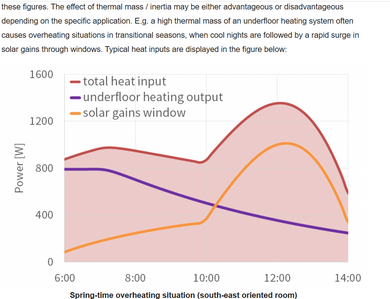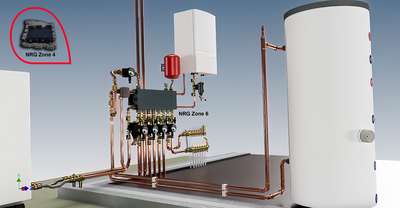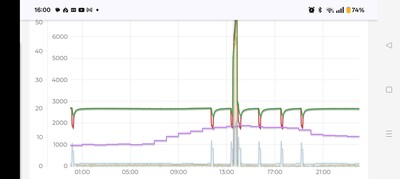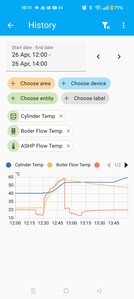Posted by: @AnonymousPosted by: @harryreaSo, rather than viewing zoning purely as a matter of room-level control or motorisnised valves, I’m interested in how zones can be used as structural tools — to segment a system into independently operating hydraulic circuits. That way, each zone isn’t just passively reacting to room temperature but is set up to allow the appliance to operate efficiently and predictably.
Isn't this making an issue way more complex than it ever needs to be - overthinking it? A system running low flow temperature and emitter sized to room, balancing is easy and to a large degree self modulating - even a radiator system can be designed to flow low temperature.
I agree (that it's overthinking).
I think people forget that rooms share heat and houses have significant heat capacity. So in many, perhaps most, cases, balancing of rooms only needs to be very approximate (I was quite shocked how easy my house was to balance even with rads running at 42), solar gain in one room distributes to others so matters less than one might fear, and the kind of arbitrary variation of individual room temperatures with time that people (and the manufacturers of smart controls) fantasize about is just that, a fantasy.
As it happens I think that what @harryrea is studying may well turn up some interesting and useful findings 'as an aside' (which is why I encourage him to post some specific details of results). However I am personally sceptical about it's direct practical impact and remain convinced that KISS is the likely winner for domestic buildings.
4kW peak of solar PV since 2011; EV and a 1930s house which has been partially renovated to improve its efficiency. 7kW Vaillant heat pump.
Posted by: @harryreaor hybrid systems
Do you even need the complexity there either. I have run my system in hybrid mode, with gas condensing boiler and heat pump. I do hydraulically separate the boiler, but just via a simple, but big plate exchanger. I just dialed in a flow temperature where the boiler would fire and run none stops for as long as I wanted it to. So can run for around 7 to 8 hours at minimum modulation (8kW against a heat demand of about 3kW) without stopping. Heat just buffering into the floor. When it switches off, it stays off, for about 12 to 18 hours. Flow temp is about 36 degs, return is close to 32. Works well. It's also used with the ASHP for DHW cylinder heating, max flow temp is generally 56 degs and cylinder settles at 53 degs. So almost no temperature is lost across the big plate exchanger and little or no distortion of either system. Heat pump can be run either in weather compensation mode or batch heat mode buffering heat to floor, system doesn't really care.
I did think about using an ERG zone, but it really added little except more pumps and costs.
So a full hybrid system is 2x pumps, heat pump one runs 24/7, boiler only as needed. One PHE, one controller for boiler using room sensor and outside temp, fires boiler when outside is below 5 degs for 6 hours or more. Zero interactions between each heat source, they operate without talking to each other via any means. A relay sends DHW call for heat to both boiler and heat pump at same time.
Posted by: @AnonymousDo you even need the complexity there either.
Hang on a moment, Honeywell, Johnson controls, Google, hive etc depends on selling us stuff we don't need. If you carry like this they will go out of business!
4kW peak of solar PV since 2011; EV and a 1930s house which has been partially renovated to improve its efficiency. 7kW Vaillant heat pump.
@johnmo Thanks, Johnmo — fair points as always.
Posted by: @jamespasolar gain in one room distributes to others so matters less than one might fear, and the kind of arbitrary variation of individual room temperatures with time that people (and the manufacturers of smart controls) fantasize about is just that, a fantasy.
Really. This is a rather sweeping generalisation. This may be valid in an old house with 2 sqm window and radiator, but different issues apply in a modern house with UFH. There are already issues with high thermal mass UFH as illustrated by the attached example with average window.
However, in the case I presented, there is 22 sqms of glass in a south-facing large open-plan lounge/kitchen. Even a cold sunny winter’s day adds beneficial heat. Nevertheless, this is totally out of sync to the northern part of the house which requires continual heating. Therefore, zone control is required. Whole house open loop working is not a panacea for all problems. I am interested in what @harryrea has to say about zoning but I am baffled as to what this solution is in respect of “buffers”, balancing, etc. It would help if he could provide a clearer diagram and simple explanation as to how this system would be configured. I am painfully aware of HP issues of minimum power, minimum flow, etc in light of which I have a need to configure a minimum 2 zone solution with very low power levels.
Private individual. No affiliation with commercial "Heat Geeks" of same coincidental name.
Posted by: @heatgeekThis is a rather sweeping generalisation. This may be valid in an old house with 2 sqm window and radiator, but different issues apply in a modern house with UFH. There are already issues with high thermal mass UFH as illustrated by the attached example with average window.
We have around 50m² of glazing on the south side, 100mm concrete floor with UFH. We can get huge solar gains if we are not careful. We run circulation pump all the time.
Not sure where your illustration came from, but operating a low flow temperature system that illustration is just way from true.
Our temperature today, 24 hr average, is 7.1 degs. It will be sunny later, we are running pure weather compensation. Last time heat pump ran was 0630. All room are pretty stable and consistent temperatures, there is a 0.7 difference in all room temps, circulation water temp is, 23.3. Since floor was last heated 5 hrs ago that flow temp is very indicative of actually floor temperature. So rooms are continuing to be heated or kept at a stable temp with a 2 Deg delta between floor and room temp. As soon as room gets to floor temp the output of the floor goes to zero in those rooms.
Also not shown in the illustration is time lag of UFH, from experiment have found we can run the UFH at elevated temperature for a number of hours during period of solar gain, the energy just buffering in to the floor.
From logging return temperature you can see a very slight rise in return temperature when we are getting solar gains, so floor is absorbing heat not giving off heat, this is then distributed around all rooms.
I have run with extensive zoning (all rooms) and as single zone. Single zone wins, for simplicity and comfort. A high thermal mass floor can have a lag of 12 hrs from heat being added and it coming out in to the room.
Posted by: @heatgeekTherefore, zone control is required. Whole house open loop working is not a panacea for all problems.
Do not agree.
@johnmo
Thanks, I appreciate your detailed walkthrough. It’s always helpful to see how experienced users approach hybrid setup challenges.
I agree your system “works,” especially where the building’s thermal mass and long on/off cycles allow for that style of operation. But I’d suggest that what looks simple at first glance may carry more cost, time, and compromise than meets the eye, especially when compared to a structured layout built around hydraulic and control separation.
For example, your large plate heat exchanger (PHE) introduces a hard boundary that needs two separate pumps, pipe sets, and fittings, and potentially adds blending, inefficiencies, and return distortion unless everything is perfectly matched. In contrast, a setup like NRG Zone 4 can achieve complete separation with one shared physical structure, pressure-neutral bypass, and clear return definition — often with less pipework, wiring, and quicker install time.
I've uploaded an example system design using NRG Zone 6, with a scaled-down Zone 4 in the corner that would suit your application better. Here’s what stands out in that configuration:
- The heat pump uses a 3-port diverter for DHW priority, but the gas boiler can continue heating space circuits simultaneously without conflict.
- The gas boiler could also be staged for DHW top-up or Legionella protection via NRG Lex or any other simple relay-based logic.
- All circuits are pressure-neutral and fully isolated, avoiding flow pulling and maintaining stable T without buffers or oversized loops.
- Installation time is reduced, layout is professional and repeatable, and future modifications (or troubleshooting) are simpler.
The goal isn’t to add complexity — it’s to embed system clarity from the start. So while your approach works, I’d argue it comes with a hidden cost in space, flexibility, and scaling — and that NRG Structural Zoning offers the same outcomes in a more replicable, serviceable, and future-ready form.
Posted by: @harryreaBut I’d suggest that what looks simple at first glance may carry more cost, time, and compromise than meets the eye,
I think your first post the one I reacted to wasn't as clear in how and why. The NRG system I have looked at in quite a bit of detail and understand the hydraulic separation offered in a simple logically manner.
My house started with a combi boiler and soon realised cooling would be a good benefit, so moved over to ASHP and ran that purely for heat and DHW via an UVC. Still had a year old boiler that I didn't want to sell for peanuts, so looked at way to integrate it. Tried a few different configurations, before settling on the design I currently run. As said previously I did consider NRG 4. But really it added no value for me due layout issues and the existing piping buried in the house fabric that connected the boiler.
Already had the PHE so that was zero cost. Boiler to PHE is about 2.5m of piping run, and to UVC another metre. However the cylinder/PHE is about 10m from the UFH manifold and another 15 to 20m from ASHP.
Have reconfigured the combi to work as a priority demand system boiler using a simple relay to switch WC on and off for either DHW or UFH. But instead of using an outdoor sensor, I use a simple resistor switched in and out of circuit so it runs at 37 degs for UFH and max of 60 for DHW.
Have attached a layout of my system, it's a little more complex than I would like, but pretty straightforward really. Good thing is I can switch off the boiler and disconnect it without breaking into the ASHP heating circuit. Which I will do if I ever get my smart electric meter running as it should.
@heatgeek I do wonder whether in a house with high thermal mass whether some degree of look ahead control would be useful particularly in the seasons where there are large diurnal variations. Room compensation is essentially rear view mirror, weather compensation is closer to real time, but neither take into account future conditions which are likely to occur within the thermal response time of the house. I don't know if the likes of homely do this but it's obvious that an internet connected controller could take into account future weather (including solar irradiation).
That said @johnmo seems to have cracked it (ignoring the complexity of the added boiler, which is irrelevant to this particular problem) without relying on the internet and weather forecasts.
Of course another approach to solar gain (which seems to be your biggest concern), well established in many countries, is simply to close the curtains! Cheap, low tech, highly effective.
4kW peak of solar PV since 2011; EV and a 1930s house which has been partially renovated to improve its efficiency. 7kW Vaillant heat pump.
@johnmo
Thanks for sharing the full schematic, Johnmo. That’s a helpful layout, and it shows just how much manual logic and layout planning are needed to make these hybrid approaches work in real homes.
From a system designer’s point of view, this reinforces why we started pushing toward a more structured zoning model. With your system, for example, the DHW setup works—but it’s dependent on the heat pump alone, meaning if you ever want to run the ASHP in cooling mode, and, if I am not mistaken, you’ll likely need to fall back on immersion heating. It also means your boiler, while capable, can’t top up or assist in DHW generation, which removes a useful tool for seasonal or high-temp needs like legionella.
Structurally zoned systems don’t just manage heating vs. hot water — they create a stable logic platform that allows these appliances to share the system without fighting each other or requiring duplicate circuits and relays. For instance, in our hybrid layouts:
- Either appliance can be used for DHW, staging, or top-up.
- The system can heat and cool while maintaining hot water availability from the non-cooling source.
- All of this is possible without buffer tanks, blending risk, or return temperature distortion.
Many systems get pieced together over time; yours clearly works on those terms. However, the goal is to make these outcomes repeatable without depending on buried circuits, hand-soldered relays, or workaround logic. That’s where structural zoning is beginning to offer something fundamentally new.
Posted by: @harryreaWith your system, for example, the DHW setup works—but it’s dependent on the heat pump alone, meaning if you ever want to run the ASHP in cooling mode, and, if I am not mistaken, you’ll likely need to fall back on immersion heating.
Just for clarity, the system will only run with the ASHP as you state, but does do DHW with cooling on operation. The ASHP just switches from cooling to heating.
Image from the monitor system for the ASHP. Dips are cooling, the bug peak is cylinder heating.
Same time frame, cylinder, ASHP and boiler flow temps. (Note the two systems aren't aligned for times)
Posted by: @harryreaFrom a system designer’s point of view, this reinforces why we started pushing toward a more structured zoning model...
I'm still struggling with this (on the grounds that it's unnecessarily complex) for the typical 100sq m, roughly cuboid, property that makes up the vast majority of the UK housing stock. I'm struggling even more when it's a retrofit for such a property, where the prime objective is a functional design that is reasonably efficient but which, crucially, involves as few changes and as little disruption as possible.
I can imagine that this might make sense in a 300 sq m plus new build, but as a general proposition for the vast majority of use cases, it's surely way 'over the top'.
Am I correct, and if I'm not correct what evidence do you have to prove me wrong? How do you propose to deploy it in a typical retrofit where at most you will have two existing primaries, one each for upstairs and downstairs, and in many cases only one primary feeding the whole property.
I guess I'm trying to get to the bottom of whether you think this is mainstream or niche, and if the former how you see it working in practical reality in the mainstream applications.
4kW peak of solar PV since 2011; EV and a 1930s house which has been partially renovated to improve its efficiency. 7kW Vaillant heat pump.
-
Bosch CS5800i 5kW - Experience So Far
1 month ago
-
My Octopus Cosy 6 Heat Pump Journey: From Quote to Completion
2 months ago
-
How to Zone with a Single Room with UFH
3 months ago
-
My British Gas – Heat Force ASHP Installation: A Frustrating Experience
1 year ago
-
Low shower pressure after ASHP retrofit
1 year ago
- 26 Forums
- 2,364 Topics
- 53.6 K Posts
- 189 Online
- 6,029 Members
Join Us!
Worth Watching
Latest Posts
-

How long will your energy contract last?
Some heat pump tariffs don’t run as long as a heat pu...
By Toodles , 4 hours ago
-

@morgan They are unsupervised these days, can’t get the...
By Toodles , 4 hours ago
-
-
RE: Octopus Cosy Heat Pump Owners & Discussion Thread
@kevh it's worth remembering that many lsvs only actual...
By JamesPa , 1 day ago
-

RE: Setback savings - fact or fiction?
Exactly. We only need to compare conditions, to decide ...
By cathodeRay , 1 day ago
-
RE: Balancing financial efficiency and comfort using the Octopus Cosy tariff
I found because I have very low heat loss I can set bac...
By RadWhisperer , 1 day ago
-
RE: Need Help Optimising My Rushed ECO4 Install: 12kW Bosch Heat Pump
Welcome @mickamills We too have an oversized 12kW Sa...
By Old_Scientist , 2 days ago
-
RE: My Powerwall 3 Consumes 3-4 kWh/Day in Self-Consumption: Is This Normal?
@caron I can confirm that the power usage of the PW3 is...
By Old_Scientist , 2 days ago
-
RE: Speedcomfort radiator fans
Thats true, but having tried (and succeeded) in constru...
By JamesPa , 2 days ago
-
RE: Solis S6-EH1P8K-L-PLUS – Why I Chose It and What I’ve Learned So Far
@bash brilliant, thanks for the feedback
By energy9165 , 2 days ago
-

RE: Heat Pump Heats the House… But It’s Not Cosy. Emitter Changes or System Tweak?
@alastair There I was, feeling grumpy, he said “Cheer u...
By Toodles , 2 days ago
-
RE: Grant Aerona: Is there a setting to keep the 2-port valve open during pump blockade
Depends on OAT. Mine cycles at OAT>10 and of course...
By JamesPa , 2 days ago
-
RE: New Fogstar 15.5kWh upright solution
@transparent My conclusion is as you have noted, tha...
By Bash , 2 days ago
-
RE: Mitsubishi Ecodan R290 10kW performance
And to you too. Wishing you a very enjoyable festive s...
By Sheriff Fatman , 2 days ago
-

RE: External pipework insulation
They do? But that isn't apparent from the photos we'r...
By Transparent , 2 days ago
-

RE: Say hello and introduce yourself
@velcro welcome to the forums. Please feel free start a...
By Mars , 3 days ago
-
Daikin EDLA11D3V3 DHW Settings
I have a newly installed EDLA11D3V3 which I'm still get...
By Velcro , 3 days ago
-
RE: Midea ASHP – how to set weather compensation
@curlykatie did you get sorted with this?
By MickaMills , 3 days ago
-
RE: MyVaillant Connect Regular Disconnect
Thanks. Yes, if the time is consistently 11pm every nig...
By buckwem , 4 days ago









